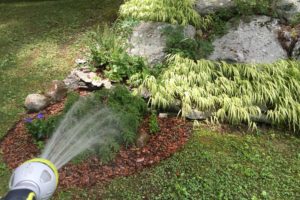Hello fellow readers, To follow are tips and protocols of watering plants.
In case you haven’t noticed, it’s been hot and dry. I’m all for zero-scaping, the trendy phonetic spelling of xeriscaping; also known as drought-tolerant or smart-scaping. In a nutshell, choose plants whose cultural needs fit our climate and avoid losing water from evaporation and run-off to reduce or eliminate the need for irrigation. Still, during times of extreme heat and drought, watering is critical, or your zero-scaping may result in zero plants. The first year of new plant installations is the most vital, though established plants perform better with irrigation when hot and dry.
Mulch drastically helps run-off and evaporation – natural mulch please, NOT the dyed kind, and no more than 3 inches thick. While plastic seems like a good idea for weed control, it prevents water from absorbing. And, black plastic further heats the soil and foliage, adding more need to water.

“I figured it mimics rain.” Good point, dear Curt, but it’s best to put water on the roots where it’s needed.
Curt helped water last night by spraying with a hose from above. “I figured it mimics rain.” Good point dear Curt, but it’s best to put water on the roots where it’s needed and to avoid wetting leaves if you can. But if you have to use sprinklers, water in the early morning so leaves have all day to dry to reduce the likelihood of foliar disease. They say only forty percent of the water from sprinklers gets to the roots of the plant. Using less wasteful drip soaker hoses or hand watering in the evening allows the plants to absorb the moisture through the night before the drying sun and heat of the next day.
It’s better to water less often and deeply than frequently only on the surface as roots will grow shallow; not preparing your plants to become drought resistant. Moisture should get six inches deep for annuals and perennials and twelve inches deep or more for shrubs and trees. Keep in mind in extreme heat and sun leaves can wilt even if the soil is moist. It’s a natural way to protect themselves from aspiration (evaporation from the leaves). Use a spade to check or with a moisture meter probe will do the trick (about ten bucks).
Too much water is just as damaging as not enough. Leaf curl, which looks like wilting, can be a symptom of too much water. Roots need to breathe, and over-watering or too thick mulch will suffocate roots, causing plant demise or failure.
The watering protocols may seem complicated, but you’ll get into the rhythm. And while you’re at it, perhaps get into the rhythm of a rain dance. Garden Dilemmas? AskMaryStone@gmail.com
Other tips: While plants prefer consistent moisture, letting the soil dry out a little before watering encourages deeper (better) root growth. Keep evenly moist – watering only one side of the plant will cause one-sided root growth and poor absorption of nutrients from the soil. If water starts running over the ground, it’s too much water at one time. Move forward and come back after it soaks in. There’s always the efficient automatic drip irrigation systems. Whoa, baby. That’s living it up!


